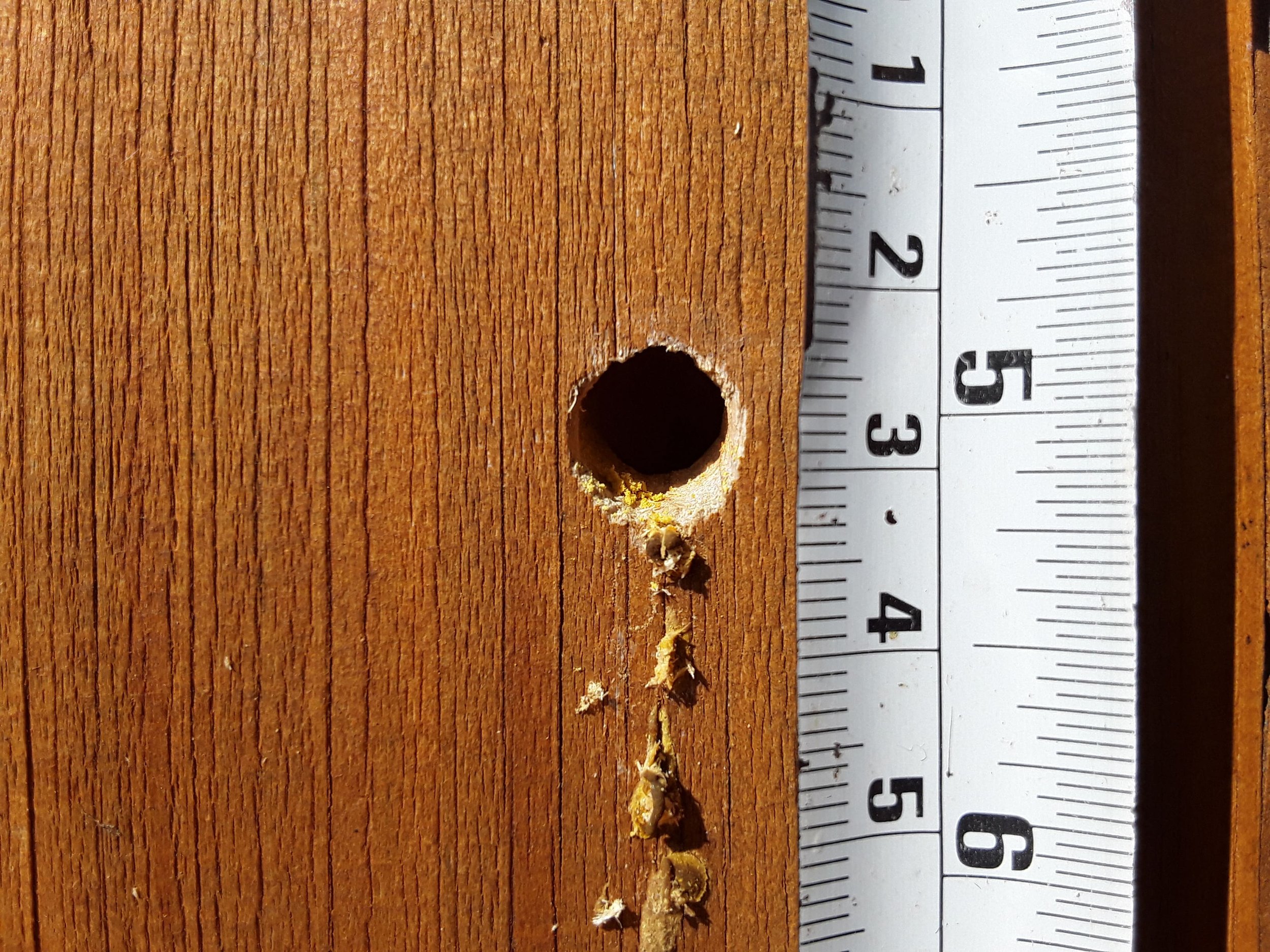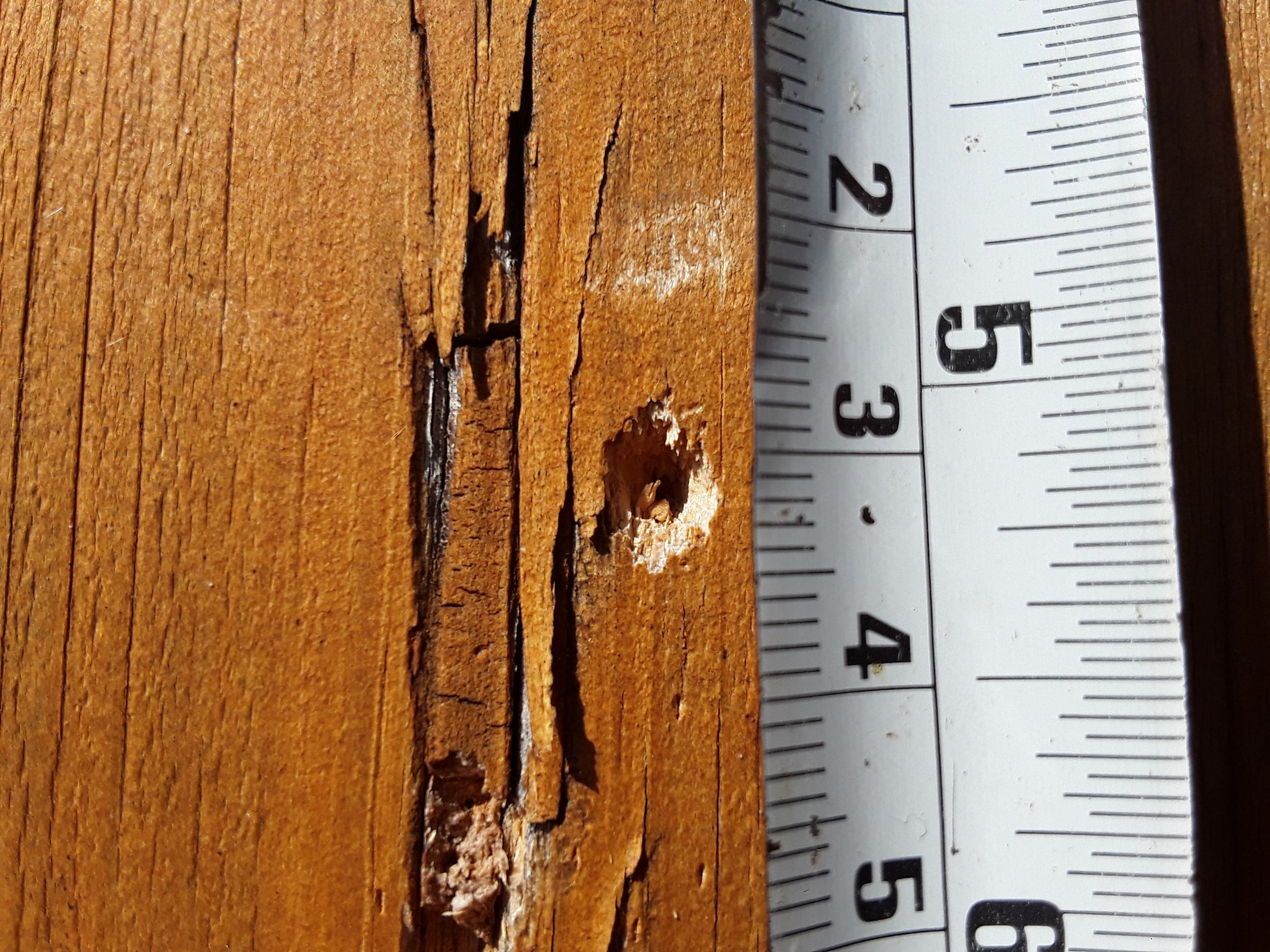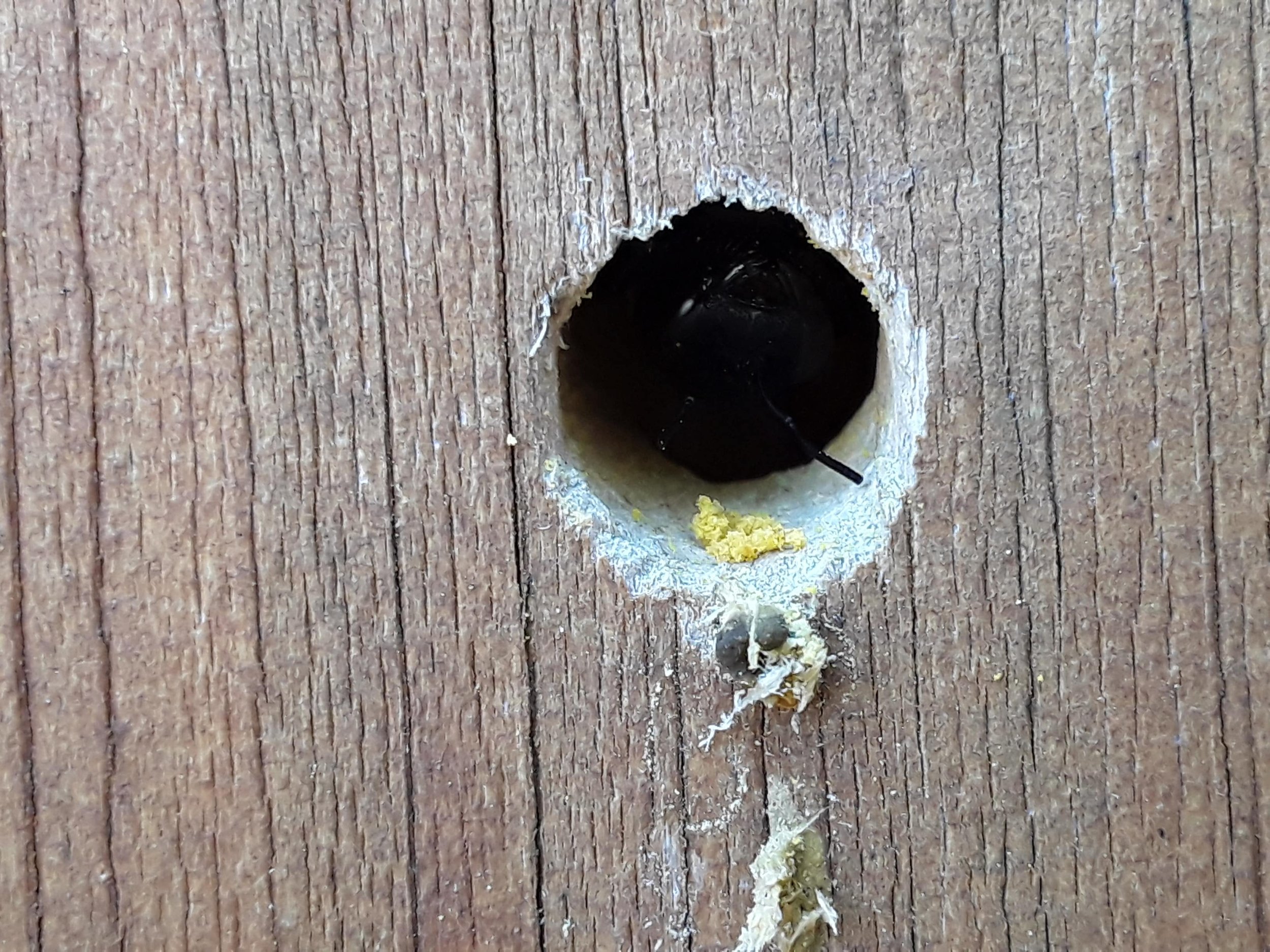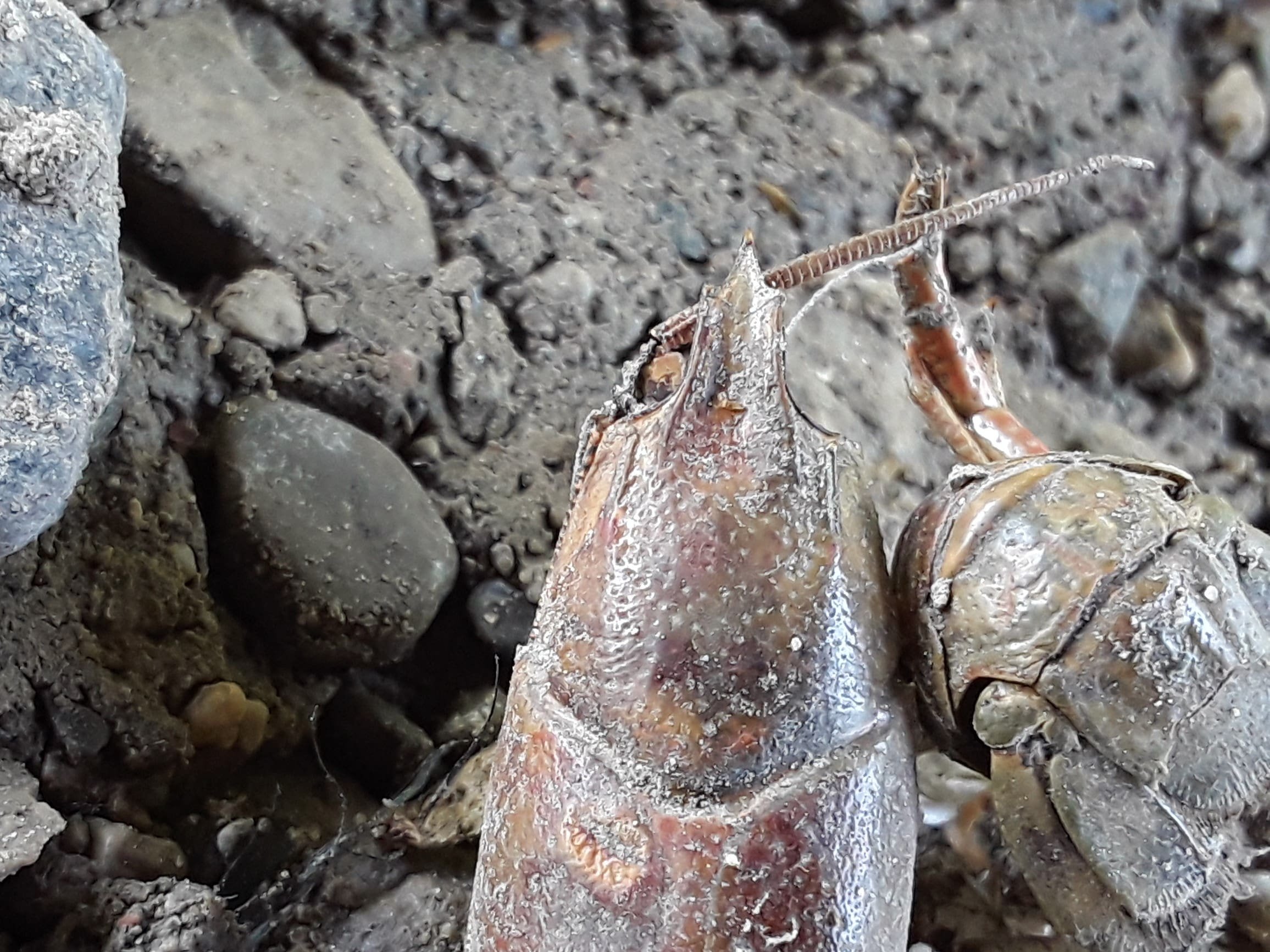Tracking Walkabout, 2023.05.29
A couple nights ago, right before recording my radio show, a friend called and asked about some hole in the side of his walled in porch/anteroom/whatever thing. He even sent some photos. While we were on the phone, something flew past him and he described it with excitement.. It was like a big bee or something but it was shiny. I knew right off who it was; Xylocopa! But I didn’t know enough about the species to be much help aside from providing the name. His description of a large shiny bee gave it away for me. I got so excited about seeing the hole this Carpenter Bee had made that I decided before my solo tracking walk the following morning I was going to stop by his place and check it out.





It was Xylocopa virginica or otherwise known as Eastern Carpenter Bee, . Xylo- comes from the Greek for wood - think xylem, and copa also a descendent from Greek, meaning to cut - like coppice. They are pretty big bees, mistaken for Bumble Bees, but in my experience, sometimes a bit larger. One source I read says they range between 13 - 30 mm long (.5 - 1.25 in). As the climate warms, the Eastern Carpenter Bees are growing more and more common in Ontario. I saw one last year when I first learned to identify them, but don’t think I had noticed them before.
They chew their own holes into the dead wood where they build their nests, and you can even hear them working if you listen close (my pal who lives there has a stethoscope so I might have to try and hear them that way). Individuals of this species can overwinter and many members of a family might shack up together. Carril and Wilson (2021) explain that they like to nest, as a crew, near human homes. They write “"nests are long galleries, used for multiple generations, but elongated each year to accommodate new members.” I am still looking into research on whether I should encourage my pals to put some more dead logs in the backyard for the bees to move into, or if they should just leave them be where they are in the porch siding. So far, I don’t know.
When I left my pals place I headed down towards the river via an overpass so I could check to see if there were any tracks under the bridge. I was grateful when I found some nice ones. I ended up sitting down next to a midsized track, a bit bigger than a Robin (Turdus migratorius), with more robust toes with wider splay. Unlike the Robin, this bird walks while on the ground, where as the Robins will run or skip along the ground. This was also under a bridge where I often see a number of this species cooing from the rafters. It was the track of a Rock Dove (Columba livia), more commonly known as a Pigeon. The track measured about 6 cm L x 4.8 cm W, which is a great fit in comparison to the numbers in Bird Tracks and Sign (Elbroch and Marks, 2001). I even drew a terrible picture of it to try and set the image in my mind (it’s not worth showing here). The coo’s from above really echoed id alongside the midsize track and walking gait. If I wasn’t sure just from the track alone, it was a good reminder to take in all of my surroundings, and not get sucked into the tunnel vision of the track.
I walked around more trying to scry more tracks from the gravelly, sandy dirt below the bridge, and I could make out some Canada Goose (Branta canadensis) tracks but often one of the toes was missing from the track so I couldn’t take any good measurements. They did seem small sometimes and I got to wondering if I could tell the difference between Mallard (Anas platyrhynchos) tracks and Canada Goose, but I don’t think I can yet.. which is something to work on.
I kept on, heading up river slowly, looking for more tracks or sign left behind, hopefully by birds, but I would take anything. I made it 2 meters, or about 6.2 feet before I had to stop and check out the next cool thing I found. It was the ripped open carapace remains of the Rusty Crayfish (Faxonius rusticus), or at least, that’s who I think they were. Although the photos don’t catch it very well, Rustys have a rust coloured splotch on their sides at the base of the cephalothorax.. They also have a slight concave to the rostrum, which you can really see in the second photo. They tend to be larger than the native crayfish in our area, and seem to be out competing them as well. In the Eramosa River, where I usually hang out, this means that the dominant species is the Rusty and we don’t often find other species.
In the only book I know of on Ontario crayfish ecologies (Crocker and Barr, 1968), they write that the Rusty Crayfish is only known in 6 locations in Ontario. Now, when you look at inaturalist, there are multiple sightings, all over the province; Guelph, Toronto, Barrie, Peterborough, Ottawa, Pembroke, Mattawa, Manitoulin, Thunder Bay, and on and on. Throughout a bunch of the province. Non-native species spread so quickly we can start to imagine the impact they have when native species may find it quite difficult to adapt and alter their behaviours to survive.
This gets me wondering.. A lot of non-native plants come in and spread and sometimes we look to them and we wonder, what is this plant actively doing here? What role is it filling? What gaps were there in the local ecosystem that this non-native species can fill? Sometimes though, I have trouble looking at species that way. Sometimes, a species is just a jerk and pushes other native species out. Sometimes the new comer to the party is just a bully and the long-standing species don’t want to hang out there anymore. I wonder if the Rusty Crayfish is a jerk? It’s important to remember that the Rusty didn’t just crawl up from the Ohio River and start pushing other species around. They were dumped here, likely by anglers or some science teachers who bought them for their kids to study, and when they were finished for the day, absentmindedly tossed them in a local stream, unaware of the future impacts. Maybe when we ditch friends, people, cohabitants, newcomers, crayfish into strange environments they have to turn it up a little to compensate for their new situation? This is totally anthropomorphizing, but it gets me thinking, and imagining things differently, and I think in a good way, so I’m fine with it. Better than treating them without kindness or consideration.
When I left the crayfish remains I walked further along the trail adjacent to the river. Its a trail that has seen a lot of camps in the past few years and there is still some debris left behind. In addition to the camps, I would also include the lack of city maintenance which I have heard has caused some people to choose not to walk down this particular trail. It is a rough uneven terrain with lots of fallen Manitoba Maples (Acer negundo) and rocky urban debris which would make it difficult for many of the cyclists who make it to the overpass, but cannot go much further. But spaces like this, the strange edge spaces, liminal portals between urban/surveilled/controlled and the wilder/cryptic/untended/unintended nature make a lot of space for other inhabitants to thrive. In other words, places forgotten by the city make good non-human animal habitat.
It doesn’t take long to encounter some sign left behind along this trail, and that is why I visit so often (1)(2)(3).
When I first came across this track I immediately recognized it as a bird, but could not identify who. I quickly developed a top three based on the arrangement of the toes (anisodactyl), location (muddy spot along the river bank), and commonly encountered birds in the area (byron’s rule states that you must assume the more common species first). The tracks measured around 5.1 cm, and for comparison the coin in the image is 23.88 mm in diameter. My top three were Common Grakle (Quiscalus quiscula), Red-winged Blackbird (Agelaius phoeniceus), and American Robin, three incredibly common birds in the area where I was tracking, and all could be found along the riverside, and all have anisodactyl arrangements of their toes.
First I could exclude Red-winged Blackbird, whose tracks range between 4.3 - 5.2 cm (1 11/16 - 2 1/16 in), because of the position of the toes. While the size could fit, Blackbirds (also including grackles and cowbirds) have a common feature of the their toe positions. Remember toes are counted in sequence from the inside towards the outside, 1 to 4 in the context of birds, beginning with toe 1, the hallux, which in blackbirds points backwards. Toes 2, 3, and 4 point forwards. Blackbird tracks, and this may apply to all species of blackbirds from all over the world, have a tendency to show toes 3 and 4 closer together towards the metatarsal than toes 2 and 3 are. For the tracks in the image above, these toes appear to be mostly evenly spaced.
If we take into account the toe arrangement as mentioned above, then we can also count out the Common Grackle. Grackles not only have the similar arrangement of toes 3 and 4 being closer together but their tracks are also a little too big for the one pictured above. Common Grackle tracks come in the range of 5.4 - 6.7 cm (2⅛ - 2⅝ in), which would be a bit too big. Sure some birds are tending to their young now, but no grackle young would yet be big enough to fill this track. I guess I have to exclude Common Grackle from the running as well.
That leaves me with an American Robin, whose tracks come in at 4.4 - 5.4 cm (1¾ - 2⅛ in), whose metatarsal (the spot on the foot where all the toes would come together and connect to the leg) tends not to show, whose track tends to curve, has bulbous toes, and definitely hangs out by the side of the river. I even went back to this spot the following day in search of any associated tracks or sign. Though I couldn’t find any feeding sign by the river, I was mostly looking for any signs of the Robin collecting mud for their nest in hopes of getting a couple of good photos of that. Robins build their first nests between early-late April around here, and will usually build a second one for a second brood after the first has fledged. They may have up to three broods per year, occurring between April - July, which makes a lot of sense when you consider how abundant they truly are.
Along the trail a couple minutes up from the Robin track I noticed a small hole on the other side of the fence from me. I couldn’t climb under the fence at this point as the gap was too small for me, and there were people on the other side of the fence who would not have wanted me on their side of the fence. I ended up looking down at the hole for a moment wondering at the size, and then decided to get lower down and see if I could make out any tracks in the dirt around, or in front of the hole or below the fence. There were none that I could spot. Perhaps this hole was used only occasionally and not many folks had visited the hole since the last rain. I find soil keeps tracks when it has just rained, or when it hasn’t rained in so long that there is so little moisture the dirt becomes brittle and dusty/sandy. This was somewhere on the dryer side of the middle of those options. It hadn’t rained in a two weeks or so, but the vegetation surrounding, the river near by, and trees arcing above must have all helped retain a little bit of moisture.
Something I did notice when I got down low was that there were a couple of hairs caught in some barbed wire at the base of the fence. The far end of the hair was white while the end closest to and caught within the barb was dark dark brown, even black. My mind shot to Striped Skunk (Mephitis mephitis). Throughout the late Winter I had been tracking Skunks who had emerged from burrows in the ground and travelled to other burrows. Some of the trails looked like they were older going in, than they were coming out. Like the Skunk had gone into the burrow, stuck around for a bit and then emerged perhaps the following day. Other trails looked so similar agewise that I assume that the Skunk must have gone in and headed out in short time. While I cannot know the timeline for this particular Skunks entrance into and emergence from this particular hole, I do believe, based on location, general size of the hole, and location and colour of the hair found caught in the wire, I am pretty certain the hair is from a Skunk. While their front claws are ideal for digging, Striped Skunks don’t often dig their own holes, but they do move into the excavations of other animals such as Groundhogs (Marmota monax) and Red Foxes (Vulpes vulpes), who also like to move into old abandoned Groundhog burrows as well. I have seen Skunk tracks emerging from burrows in the past but I didn’t see them this time.
While my wander continued on, checking out flowers and fungi, I didn’t pay too much more attention to the tracks along the trail. I will continue to keep an eye out for all things birds for the next while as I feel like their tracks and sign are still a big blind spot for me. Hopefully I’ll learn to see better over the next few months.
To learn more :
Bees of Toronto : City of Toronto Biodiversity Series (available online as a pdf)
Common Bees of Eastern North America by Olivia Messenger Carril and Joseph S. Wilson. Princeton University Press, 2021.
Handbook of the Crayfishes of Ontario by Denton W. Crocker and David W. Barr. University of Toronto Press, 1968.
Bird Tracks and Sign by Mark Elbroch and Eleanor Marks. Stackpole Books, 2001.






